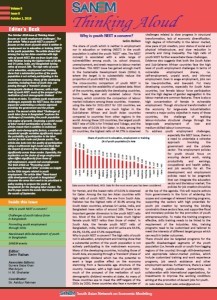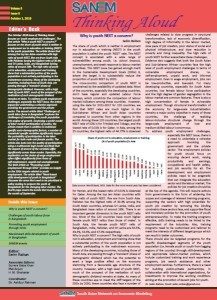
Thinking Aloud: Volume V, Issue 5
 The October 2018 issue of Thinking Aloud focuses on ‘youth employment challenges’. The first article “Why is youth NEET a concern?” focuses on the share of youth which is neither in employment nor in education or training (NEET) in the youth population. The article shows that among the top ten Asian countries with the high ratio of youth NEET, five are from South Asia with Pakistan having the highest ratio of 30.4% and Sri Lanka, India, and Bangladesh having ratios of around 28%. The high ratio of youth not in education, employment and training show that a substantial portion of the youth population is not actively participating in the mainstream economy. Many of the developing countries, including those of South Asia, are passing through a ‘transient’ phase of the demographic dividend. However, with a high level of youth NEET, much of the prospect of the realization of such demographic dividend remains at stake. To address youth employment challenges, especially the NEET issue, the article argues for undertaking a cohesive approach involving the government and the private sector. The second article titled “Challenges of youth labor force in Bangladesh” explores the challenges of translating the youth population into an engine of growth. Employing a probit model of labor market participation of youths, the article https://dietitianlavleen.com/where-to-get-ativan/ reveals that in addition to individual specific socio-demographic factors, a number of household-specific variables significantly impact the probability of participation in the labor market for both male and female youths. The article also looks into the quality of participation using a multinomial logit model and finds that the impact of several of the variables differ significantly across these modes. Especially, the implication on the choice of wage employment often differs significantly from those of self-employment, unpaid and unemployment. Finally, the article highlights the need for effective skill development programs, quality higher education, and market-based curriculum development to address the skill mismatch and underemployment issues. The third article on “Promoting youth employment through SDGs” provides an insight into the SDGs targets related to youth employment. The article emphasizes that while global initiatives can at best assist the countries in achieving the ambitious goals, rapid action at national levels is required to overcome the country-specific challenges of youth employment. The article titled “Need-based skills development of youth in Bangladesh” discusses the areas that need to be prioritized in policy making to prepare the youth of Bangladesh for the changing labor market. The fourth page covers the events that took place in the month of September.
The October 2018 issue of Thinking Aloud focuses on ‘youth employment challenges’. The first article “Why is youth NEET a concern?” focuses on the share of youth which is neither in employment nor in education or training (NEET) in the youth population. The article shows that among the top ten Asian countries with the high ratio of youth NEET, five are from South Asia with Pakistan having the highest ratio of 30.4% and Sri Lanka, India, and Bangladesh having ratios of around 28%. The high ratio of youth not in education, employment and training show that a substantial portion of the youth population is not actively participating in the mainstream economy. Many of the developing countries, including those of South Asia, are passing through a ‘transient’ phase of the demographic dividend. However, with a high level of youth NEET, much of the prospect of the realization of such demographic dividend remains at stake. To address youth employment challenges, especially the NEET issue, the article argues for undertaking a cohesive approach involving the government and the private sector. The second article titled “Challenges of youth labor force in Bangladesh” explores the challenges of translating the youth population into an engine of growth. Employing a probit model of labor market participation of youths, the article https://dietitianlavleen.com/where-to-get-ativan/ reveals that in addition to individual specific socio-demographic factors, a number of household-specific variables significantly impact the probability of participation in the labor market for both male and female youths. The article also looks into the quality of participation using a multinomial logit model and finds that the impact of several of the variables differ significantly across these modes. Especially, the implication on the choice of wage employment often differs significantly from those of self-employment, unpaid and unemployment. Finally, the article highlights the need for effective skill development programs, quality higher education, and market-based curriculum development to address the skill mismatch and underemployment issues. The third article on “Promoting youth employment through SDGs” provides an insight into the SDGs targets related to youth employment. The article emphasizes that while global initiatives can at best assist the countries in achieving the ambitious goals, rapid action at national levels is required to overcome the country-specific challenges of youth employment. The article titled “Need-based skills development of youth in Bangladesh” discusses the areas that need to be prioritized in policy making to prepare the youth of Bangladesh for the changing labor market. The fourth page covers the events that took place in the month of September.
Tag: youth employment, NEET, skill development



